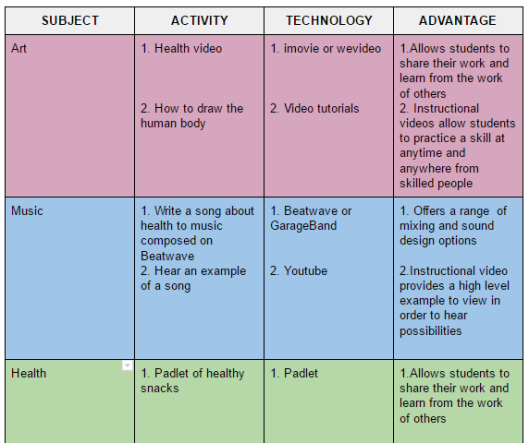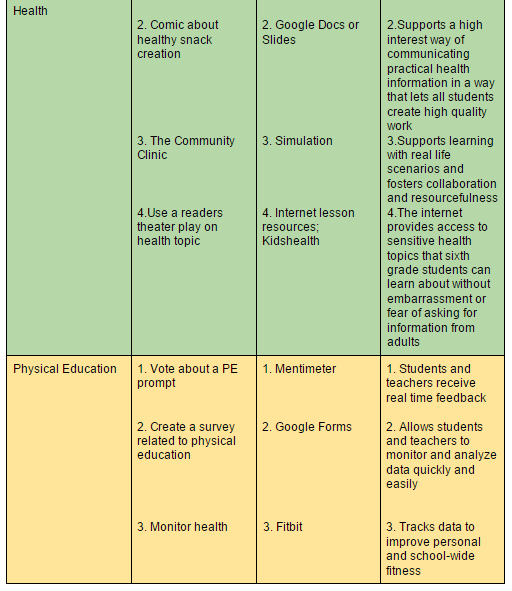I’ve always enjoyed cross-curricular lesson planning. Not only does it make sense because it enhances the learning process to be looking at subject matter in multiple ways, it also frees up time to pursue class interests or activities that don’t perfectly match the common core standards. When teachers are experienced enough to blur the lines away from a rigid subject matter schedule, cross curricular lessons can be magical for both students and teachers. These are the lessons when my class and I have experienced learning without any attention to the clock. Usually there is always one student every year who was a clock watcher, for better or worse, and reminded us that recess was half over.
The new challenge within this module of study was to look at cross-curricular planning with an eye focused on the benefits of technology integration. I focused on integrating technology enhanced arts, health, and physical education with my sixth grade opinion writing unit. This unit originally integrated health which is why you see health covered so heavily below. Here is a link to my Buncee which supports the chart below.
I have a personal teaching story to share about the benefits of technology in music programs. Last year my fourth grade teaching partner and I decided that our students would benefit from a half day field trip to the Oregon Symphony’s Young Peoples Concert. When I announced the field trip they moaned and groaned about how boring it would be. I worried a bit about this myself, but I was assured by my teaching partner that the conductor does an excellent job tailoring the experience for kids. Fortunately, the conductor did and the experience changed some attitudes about remaining open to new experiences for about half of the students. In order to build anticipation and some familiarity with the music, each teacher was provided with a cd of the music that would be played. I turned it on as background music. Nothing. I tried having the students act out how they felt while the music was being played. Aha! I had complete skits without words and too little time for all the volunteers to perform. Now that I had found a way to connect them to music that was originally foreign to them, I could rest assured that I now had data from them in order to finalize plans for our time together after the field trip. I told them that I had a secret activity planned and it involved the iPads. When we returned I introduced them to Beatwave which is a free music composing app. I helped them connect the dots that music doesn’t happen without a composer and they would get to be a composer for the afternoon. They were asked to share their best one minute composition with the class by day’s end. As stated in Integrating Educational Technology into Teaching (2016),
Today, the desktop music production software industry is helping accelerate a trend away and from reliance on printed sheets and toward an audio artifact. This means that many students who are discouraged by a requirement to learn notation theory can now participate as composers and performers. (p.356)
It’s time our music programs get updated and meet the needs of the learners in front of them. Despite having an amazing music teacher at our school, music class, presented in the traditional way, isn’t holding students’ attention which creates a frustrated teacher and ill-behaved students. Technology can help address many of the same issues across the curriculum. (p. 356)
Resources
Roblyer, M. (2016). Integrating Educational Technology into Teaching (7th ed.).
Massachusetts: Pearson.



These are all great ideas to integrate various subjects into your classroom. I teach courses that are required for graduation requirements; students must pass the class and pass the state test for each course. New teachers, experienced teachers, and veteran teachers of the content all struggle to cover all of the topics prior to the ever-looming testing date. We all enjoy the idea of joining up with another class to explore content from different perspectives, but we cannot justify losing a day or 2 of instruction and practice when we do not have enough time as it is.
My friend teaches math in a middle school, so she has a bit more flexibility with her schedule and pacing than the high school courses. However, her math classes are mixed grade level while their social studies, English, and science classes are all grade-level teamed. The science, social studies, and English teachers accomplish some cross-curricular lessons within their team, but the math department always misses out because she cannot plan to coordinate 7th grade and 8th grade subjects at the same time. Any suggestions?
LikeLike
Hi Amy,
Thanks for your response. I empathize with you and the pressure you are receiving to get students to learn something in order to pass a state test. Unfortunately, this learning environment isn’t conducive in supporting kids to be life long learners.
I help coordinate learning materials for struggling readers at the elementary level. The reading programs of the past are so dull and prescriptive. I am putting time into finding more engaging and high interest stories for the kids, but this takes an enormous amount of planning time. Then I still have to teach my assistant how to utilize the materials I just put together!
When I think back on my own math education, I always come back to one positive experience- senior year. Prior to that year, I fit the example that you hear about in math research studies of a girl who started receiving C’s in math from middle school on. Since I was college bound I was determined to continue taking math during my senior year so that I wouldn’t get further behind. I opted for a math problem solving course. It was wonderful! The basic format each day was something like this: Teacher models a multi-step word problem somewhat rooted in real life and shares his thinking along the way. Then he gave us too many problems to truly solve in one class period. We got to decide which problems we wanted to work on, whether we worked alone or in a group, and the teacher was available any time inside and outside of class to receive feedback. This totally lowered my anxiety level, provided a supportive environment to learn from others, and allowed for immediate feedback to move my learning forward. I still thank this teacher today and I love teaching math.
~Michelle
LikeLike
Your experiences with cross-curricular education is fascinating. I encounter single content material except in in our capstone course. Your experiments in engaging students in the symphony field-trip are inspiring. I was particularly impressed with the response of the students when you introduced the iPad activity. Through reading blog posts such as this, I feel that I am learning to broaden my own teaching approaches.
LikeLike
Thanks for the encouraging words, Peter! I love curriculum and instruction and would probably have headed that route with my master’s degree if they hadn’t started cutting this administrative position in my state. Fortunately, you still need to be an expert with curriculum and instruction in order to work within the field of educational technology! I’m having fun integrating my edtech learning as an instructional coach at the elementary level. This is a much better fit for me as opposed to taking a position in the technology department in my district.
~Michelle
LikeLike